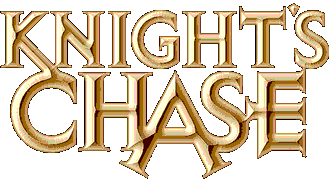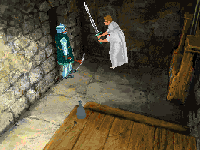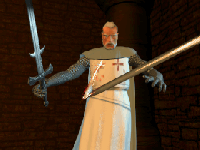

History: Previous games include Alone in the Dark which resemble this game. If you liked the one, well, you probably will like this one. Everything except the story is the same: the graphics, the combat, the puzzle interface, and screen snap shot save games.
Plot: The Knights Templar, (or were they the Knights Tempura?), were a
mysterious bunch, leaving treasures buried in hillsides, starting
castles in far away places, and defending Christianity against invading
hordes. When the Knights are betrayed, yet again, by a King, no less,
and a deputy to the Grand Inquisitor named Wolfram. The remaining
Knights are rounded up and killed. Why this King and deputy Inquisitor
are interested in a future descendent of a past Templar is not all that
clear. All of a sudden you are doing a lot of very weird stuff, and
why, who knows?

Far in the future an American law student named William Tibbs is whisked off from the Paris of the present to the 14th century Paris with his fiancee Juliet ("American in Paris"? -Ed.). Somewhere along the line, Juliet is separated from William, who must now seek her out and save her from the evil doers. An interesting twist would have been to let gamers play the game from Juliet’s perspective, but this was not an option in the chauvinistic game.
Puzzles mostly center about how to use or combine objects, such as a catapult, water, a bucket, and others to perform certain actions such as retrieve another essential artifact like a key so that the story can progress. Some puzzles are unnecessarily divisive and unrealistic like getting the key from the pot, which in most real world situations would be very easy but in this virtual world become a nightmare of difficulty due to the designer’s twisted sense of humor.
The objects you need to collect and manipulate are somewhat harder to find due to the number and diversity of camera angles.
Interface: The animation has hot spots that you may examine, manipulate or pick up items from. The cursor seems to move around the screen by itself after movement. The commands are fight, open or search, options and movement including walk forward and backward, run, turn, and fight with fists or weapons.
Movement is by cursor keys and the spacebar performs an action. Actions require a second screen and selection of the appropriate action from a menu. Hotkeys would have been a more effective alternative. The early Ultima games effectively used every key on the keyboard to perform dozens of actions without the need for elaborate menus.
Grahics in the regular game are not noticably of higher quality than seen in Alone in the Dark. Game play is always preferable over beautiful graphics. Some of the best games were created five to ten years ago.
Animation: While looking quite realistic the characters move in a very
unnatural way making them appear like mere automatons.

Video: The opening movie is quite nice with a highly detailed three dimensional (3D) Knight swinging a sword in a 3D castle in France. After the movie the graphics are less striking and less appealing. The backgrounds are hand drawn two dimensional and are less distinct than the 3D cinematic movie cut scenes. The camera angles are cinematic with constantly changing dynamic views.
Music: Orchestral themes open the game and become MIDI music a little later.
Speech: Human voice actors take care of the dialogue.
Hints: The game is quite lethal so crank down the difficulty level. Be careful to move slowly in the museum and watch out for lasers. The cinematic views make it hard to fight so be careful to wait until the right time to begin a battle. The items you need to manipulate and collect can be easily seen as standing out from the background since they are composed of polygons and not rendered graphics. Alarm systems are often featured as articles in magazines so that those studying security know how to use them. A useable sword and shield are found in the room with a lot of cameras.
Manual: Tiny jewel case manual for all items. Nice stand up reference card.
Future plans: Knight’s chase is part of the Time Gate game trilogy planned around the plot line of the first game.
Bugs: The game is not flawless. Several irreversable glitches and graphic anomalies have been reported, but none of them were fatal to the game which always had a work around.
No multiplayer features are supported by the game.
Reviewing the Reviews: Seem to be divided between liking this one and hating it.
References:
Jason MacIsaac, www.gamesmania.com/english/reviews/new/knight.htm, 6/10 (60%).
Morgana, www.cdmag.com/adventure_vault/knights_review/page1.html, Computer Games Strategy Plus, issue 70, September, 1996, pg. 110, 3/5 (60%-80%).
Jeff Toney, www.gamepen.com/softwarepen/pc/knight_chase.html, B, (85%).
Ron Dulin, www.gamespot.com/adventure/knightsc/index.html, 64%.